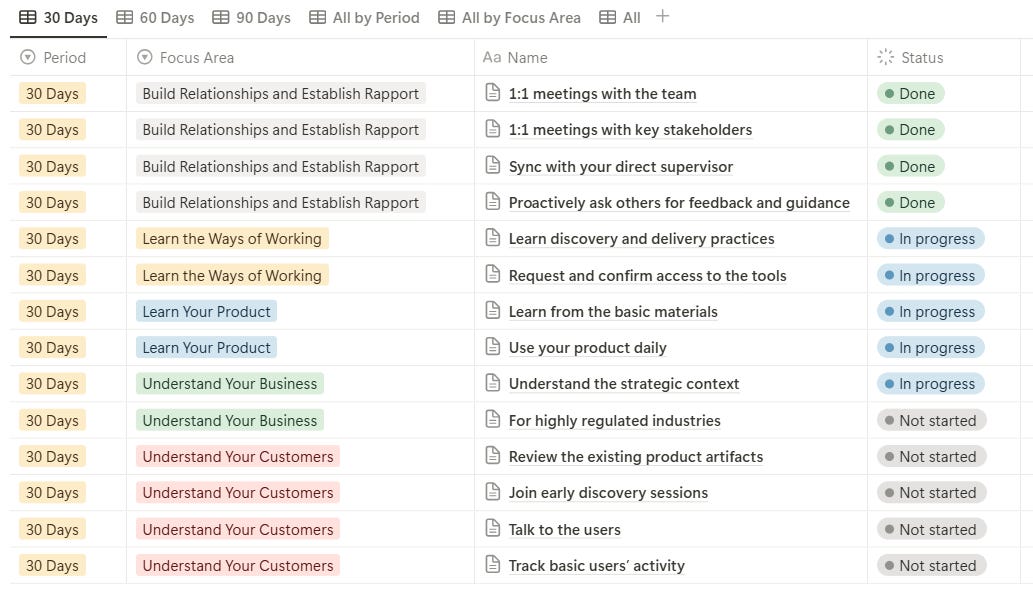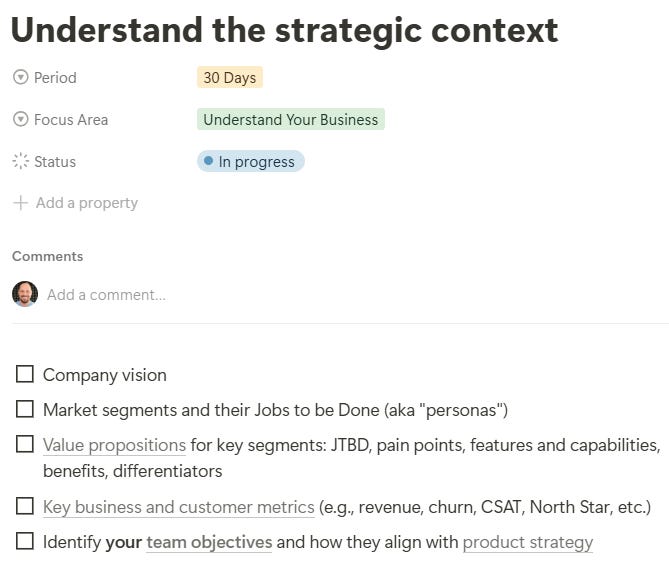Product Manager Onboarding: Your First 30/60/90 Days
How to drive maximum impact step-by-step. Notion template with a proven PM onboarding framework. What you should do in your first 30, 60, and 90 days.
Hey, Paweł here. Welcome to the premium edition of The Product Compass Newsletter!
Every week, I share actionable insights and resources for PMs. Here’s what you might have recently missed:
Consider subscribing and upgrading your account for the full experience:
🚀 Announcement: I will fully commit to this community starting March 1
Before we go further, last month, I turned 40. Just a few days earlier, I made a decision: Starting March 1, I’ll fully commit to our community! 😊
It was one of the toughest choices of my career. Ideals is the best product organization I’ve ever been part of. Just like the ones Marty Cagan describes. It has inspired many of my posts.
But balancing writing and a full-time job meant giving up more and more personal time, especially with my kids.
And I couldn't imagine walking away from The Product Compass.
I’m excited to dive into deeper research projects, explore new collaborations, and connect more closely with all of you soon.
P.S. I can’t express how grateful I am to all the paid subscribers who helped make this possible. You’re amazing!
Today, I’m sharing a Product Management onboarding framework I’ve refined over the years and tested across different organizations. It’s designed to help you:
Maximize your impact as a Product Manager when joining a new company.
Evaluate the Product Manager onboarding plan in your organization.
Here’s what we’ll cover:
Your First 30 Days as a Product Manager: Relationships and Learning
🔒 Your Days 31-60 as a Product Manager: Deeper Understanding and Quick Wins
Your Days 61-90 as a Product Manager: Driving Impact
[Notion Template]: Product Manager Onboarding: First 30, 60, 90 Days
You may need to adjust the timeline and details to fit your organization. One of your first tasks is to confirm your onboarding plan with your direct supervisor and set up recurring 1:1 meetings.
P.S. Thank you,
and for reviewing this one!1. Your First 30 Days as a Product Manager: Relationships and Learning
The first 30 days of your Product Manager onboarding are about building relationships, establishing rapport, and learning as much as possible about your product, customers, ways of working, and the strategic context.
The generalized framework that has always worked best for me:
Each item in the Notion collection contains a list of subtasks, for example:
Let’s dive into the details.
1.1 Focus Area: Build Relationships and Establish Rapport
Have 1:1 meetings with the team:
Your team (Engineers, Designers, QA, PMM)
Other PMs (ask them to present their areas)
Have 1:1 meetings with key stakeholders:
Marketing, Sales, Success, Support, Finances, Legal, Head of Product
Map their power, interest, and communication preferences to engage them properly (see the 2x2 Stakeholders Map Template)
Sync with your direct supervisor:
Confirm your onboarding plan and performance metrics with your supervisor
Set recurring 1:1 to discuss your progress, challenges, initiatives, and feedback
Your attitude: Proactively ask others for feedback and guidance
1.2 Focus Area: Learn the Ways of Working
Learn discovery and delivery practices:
Product discovery
Scrum events
Quality assurance
Production bugs
Releases, environments
Request and confirm access to the tools:
Product analytics (e.g., Amplitude, Clarity)
Design/collaboration tools (e.g., Figma, Miro, Notion, Jira, Confluence, Slack, Slack channels, and other specific "workspaces" and "wikis")
Customer feedback channels and account management (e.g., Intercom, CRM)
1.3 Focus Area: Learn Your Product
Learn from the basic materials:
Review onboarding wikis/videos
Review internal and public documentation
If possible, shadow a customer onboarding call
Use your product daily:
Understand core use cases and user flows; one technique is to help with testing
Identify at least 3 key insights or potential quick wins, share them with the team
1.4 Focus Area: Understand Your Business
Understand the strategic context:
Company vision
Market segments and their Jobs to be Done (aka "personas")
Value propositions for key segments: JTBD, pain points, features and capabilities, benefits, differentiators
Key business and customer metrics (e.g., revenue, churn, CSAT, North Star, etc.)
Identify your team objectives and how they align with product strategy
For highly regulated industries:
For some industries (finance, healthcare), understanding relevant regulations (GDPR, SOC 2, HIPAA) and how they might affect the product is critical
1.5 Focus Area: Understand Your Customers
Review the existing product artifacts:
Product Backlog
Recent release notes
Feature requests
Product roadmap
Interview transcripts
Support chats and calls
Opportunity Solution Tree for your team
Join early discovery sessions:
Collaborate with Designers and Engineers to learn about the current opportunities, ideas, and assumptions
Talk to the users:
Conduct at least 4-8 exploratory customer interviews or visits
Consider shadowing interviews organized by other PMs
Document key user needs and pain points
In B2B, reach out to other decision-makers (buyers)
Track basic users’ activity:
Start using product analytics
Review events, session recordings, surveys (e.g., CES or CSAT) to spot basic patterns
2. Your Days 31-60 as a Product Manager: Deeper Understanding and Quick Wins
🔒 Upgrade your account, if you haven't already, to continue and access a dedicated Notion template 👇
Keep reading with a 7-day free trial
Subscribe to The Product Compass to keep reading this post and get 7 days of free access to the full post archives.





